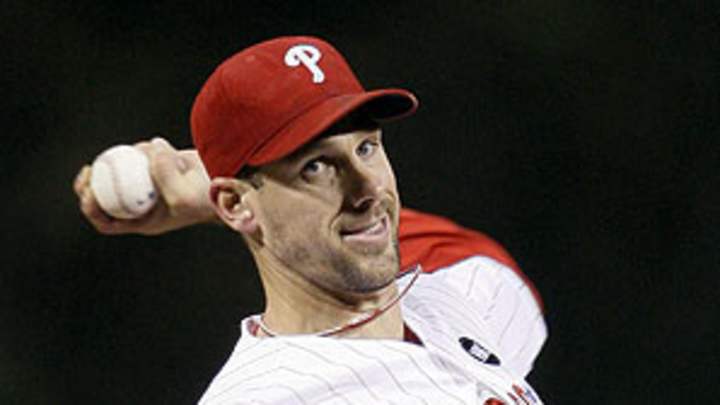Projecting how Phillies' Big Four starters will perform in 2011

My go-to statistic here is going to be Baseball Prospectus's Support Neutral Lineup-adjusted Value Above Replacement (SNLVAR), which is a cumulative win-expectancy-based statistic that measures the value of starting pitchers in wins. In short, it uses win expectancy to measure a starter's effect on his team's chances of winning each game he pitches, credits (or debits) the pitcher a portion of a win for each of his starts, adjusts those totals for the strength of the opposing lineup and the run support the pitcher received, adds up all those partial wins, and compares it to how a replacement-level pitcher (think an emergency starter off the waiver wire or a non-prospect out of Triple-A) would have performed.
Since the four pitchers we're dealing with all have a fairly well-established level of performance, I'll base my projections on their last few seasons. Roy Halladay, for example, has been consistently among the best pitchers in baseball the last three years, so I'll simply average his last three seasons to get his 2011 projection. Lee's Cy Young award-winning 2008 campaign was a bit above the level of his last two seasons, which were still excellent, so I'll base his projection on an average of his last two seasons only. Hamels' 2008 season, in which he led the Phillies to just their second World Series title, and 2010 season were very similar. Thus, given that he's just 27, I'm going to toss out his 2009 season as something of a Verducci Effect (and batting-average-on-balls-in-play-inflated) hangover from 2008 and average his 2008 and 2010 seasons, because there's little reason to expect regression from him at this point in his career.
Oswalt is a bit more of a puzzle. His ERAs the last three years have been 3.54, 4.12, and 2.76. That middle mark owed some to his struggles with a degenerative disk in his back, but the thing about degenerative conditions is that they don't get better. They can only be managed effectively, as Oswalt did last year. Also, his 2.76 mark this past season owed some to good luck on balls in play, particularly in his two months with the Phillies. Oswalt's opponents had just a .258 BABIP in 2010 compared to a league average (and Oswalt's career mark) of around .300. For those reasons, I'll average those three seasons, but knock a little bit off the resulting SNLVAR.
Here, then, are my 2011 projections for the Phillies four aces:
The win totals might look low for Lee and Hamels especially, but those are based on their actual totals from recent seasons. Besides, the only wins that really matter in the above lines are the wins above replacement in those SNLVAR totals, and the above projections give my projected version of the Phillies' four aces a total value of 26.6 wins above replacement. By way of comparison the top team SNLVAR total in the majors in 2010 was 25.5 by both the Phillies and Giants, the two NLCS combatants. If the Phillies manage to get anything positive out of the fifth spot in their rotation -- which is difficult to project right know given that the Phillies are actively shopping Joe Blanton in an effort to help pay for Lee's new contract, --they should beat that by a comfortable margin.
As for the historic place of the Phillies 2011 rotation, Baseball Prospectus has only calculated SNLVAR back to 1954, but in those 67 seasons, a total of 26.6 wins above replacement would only get the Phillies up to 71st on the all-time list, tied with the rotation of the 2001 world champion Diamondbacks led by Randy Johnson and Curt Schilling. The most recent rotation to beat that 26.6 SNLVAR by more than a win was the 2005 Astros of Oswalt, Roger Clemens and Andy Pettitte, which came in at 29.6 wins above replacement.
The greatest rotations since 1954, according to SNLVAR, were those of the 1997 Braves and 1966 Dodgers, both of which were worth 33.6 wins above replacement. That shouldn't come as any great surprise. The Dodgers of 1966 were the last team to feature Sandy Koufax and Don Drysdale and the first to include rookie Don Sutton. That's three Hall of Famers to match the '97 Braves trio of Greg Maddux, Tom Glavine, and John Smoltz, all of whom are Cooperstown-bound. Here are the top four pitchers by SNLVAR in those two rotations alongside my projected totals for the 2011 Phillies:
Where the Phillies four fall short is not on the back end, but up top. As great as Halladay is, he has never dominated over a full season the way Koufax or Maddux did, and it would take a season greater than his just-completed Cy Young award-winning campaign, plus an award-worthy season from either Lee or Hamels, to get the 2011 Phillies into the neighborhood of the '97 Braves or '66 Dodgers. Given that Halladay will be 34 in May, that seems unlikely, but it's no shot against the 2011 Phillies that their top four will be merely great rather than the greatest.
